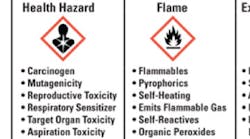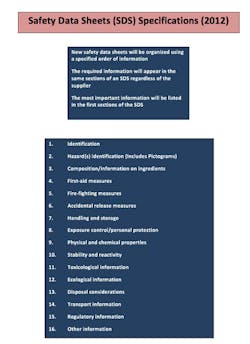OSHA final deadline is near: HazCom compliance in the dental practice
In 1994, the Occupational Safety and Health Administration (OSHA) Hazard Communications Standard (HCS) was enacted to ensurechemical safety in the workplace, and this includes dental practices. Employers are charged with providing all employees continuous and understandable information about the identities and hazards of all chemicals in the workplace.
Based on the mandates of this standard, chemical manufacturers and importers are required to evaluate the hazards of the chemicals they produce or import, and prepare labels and safety data sheets (SDS) to convey the hazard information to users. Employers with hazardous chemicals in the workplace must have labels and accessible SDS documents for their exposed workers, and train them to handle the chemicals appropriately.
On March 26, 2012, OSHA announced a significant change in the HCS and revised “hazard determination” to a specific requirement for hazard classification of chemicals. This revision also mandated the standardization of label “pictogram” elements for containers of hazardous chemicals, and specified a new format and required content for all SDSs.
Since the 2012 revision mandates and entirely new standardized approach to hazard communication, OSHA specified that employers must have provided employees initial training by December 31, 2013, on this revision to ensure that they can access and use these new communication elements as they become integrated into mainstream use. It remains that employers must provide employees effective information and training on the hazardous chemicals in their work areas at the time of initial assignment with a chemical, and when a new hazardous chemical is introduced into the work environment.
Chemical manufacturers, importers, and distributors were given the deadline of June 1, 2015, to provide new labels and new SDS forms to consumers, and a deadline of December 1, 2015, to assure shipping containers containing known hazards bear the new HCS-compliant label.
For the dental office, the final deadline to the transition of this revised standard is approaching on June 1, 2016. This is the time at which all employers must have completed the update for the alternative workplace labeling and hazard communication program as necessary, and provide additional employee training for newly-identified physical or health hazards.
As a dental assistant, you may have been assigned the task of managing the Hazard Communications Program for your dental office. Are you ready to meet this new federally-required deadline of June 1, 2016? Have all of your SDS forms been updated to comply with the specifications of the new standard? Have you converted your workplace labeling to the new label elements of the HazCom 2012 pictograms? Have you included the information of the revised standard in your HazCom training materials for employee training sessions? Only four months remain until this important deadline must be met, otherwise the practice will be non-compliant with federal safety mandates.
According to OSHA: “The Hazard Communication Standard (HCS) is now aligned with the Globally Harmonized System of Classification and Labeling of Chemicals (GHS). This update to the Hazard Communication Standard (HCS) will provide a common and coherent approach to classifying chemicals and communicating hazard information on labels and safety data sheets. This update will also help reduce trade barriers and result in productivity improvements for American businesses that regularly handle, store, and use hazardous chemicals while providing cost savings for American businesses that periodically update safety data sheets and labels for chemicals covered under the hazard communication standard.”
For additional references to help you understand the standard and assure compliance, visit osha.gov/dsg/hazcom/index.html.
The American Dental Assistants Association (ADAA) has proudly been the recognized voice of dental assisting for over 90 years. It remains committed to promoting quality dental health care to the public and enhancing the public image and stature of the dental assisting profession. For more information on the Association, visit adaausa.org.






